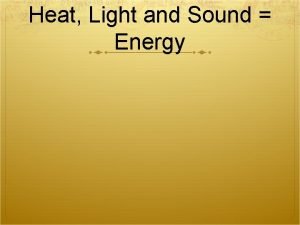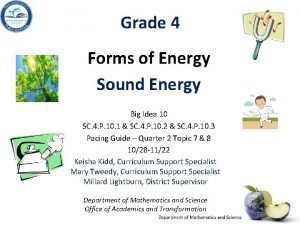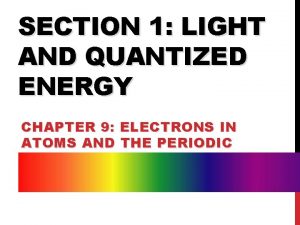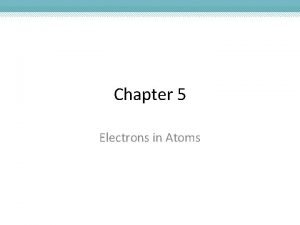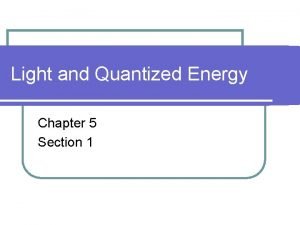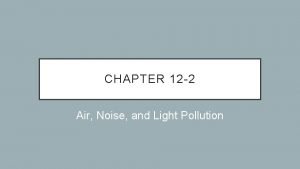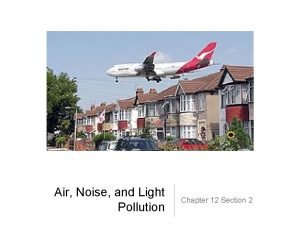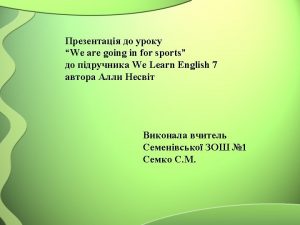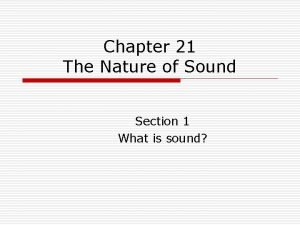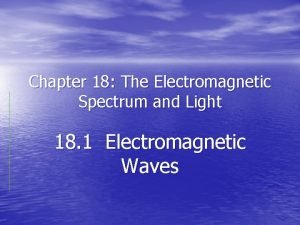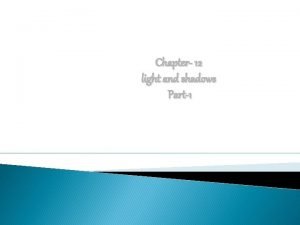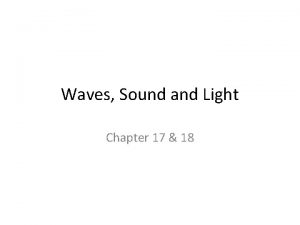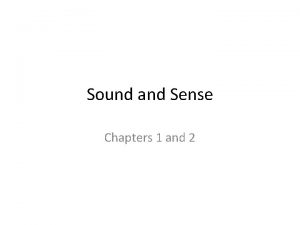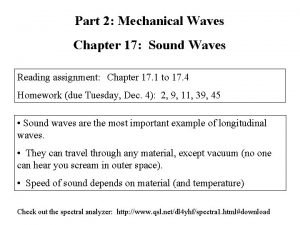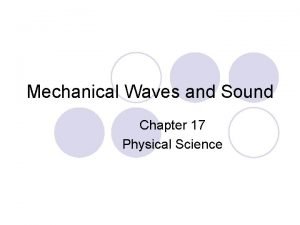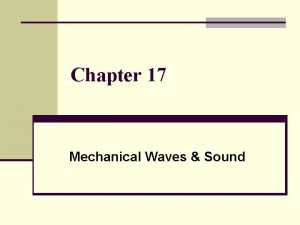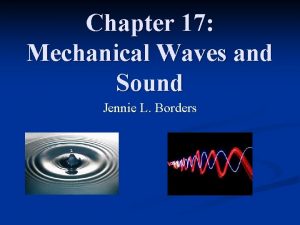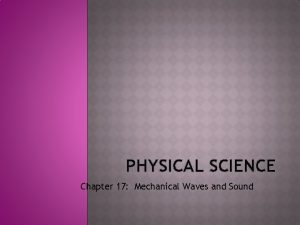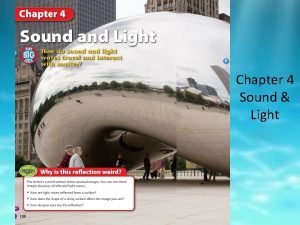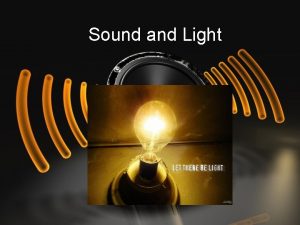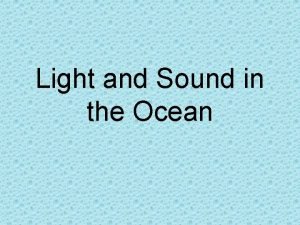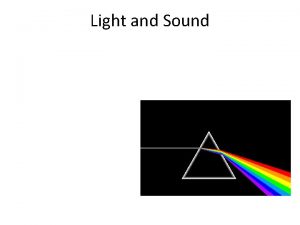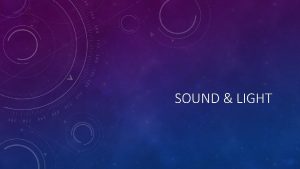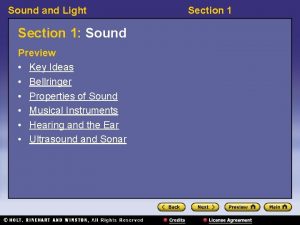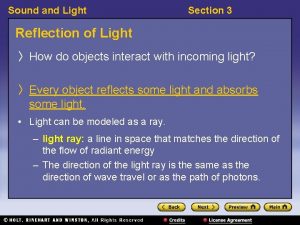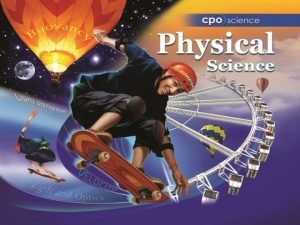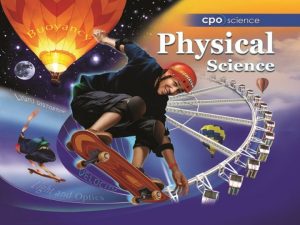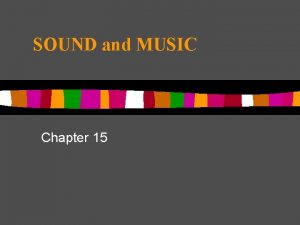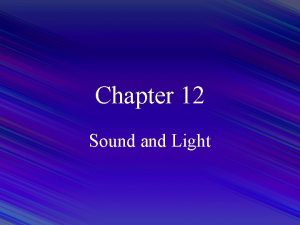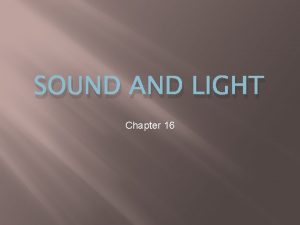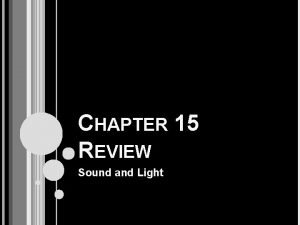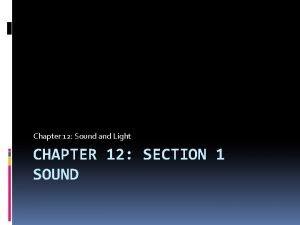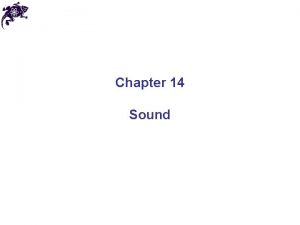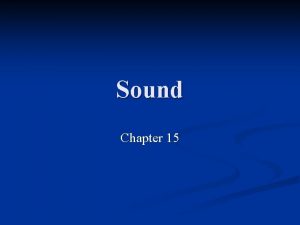SOUND AND LIGHT Chapter 15 SOUND Section 1




































- Slides: 36

SOUND AND LIGHT Chapter 15

SOUND Section 1

Properties of Sound � Sound Wave- a longitudinal wave that is caused by vibrations and travels through a material medium � Spread out in all directions away from a source

Properties… � Speed of Sound depends on the medium � How fast the medium transfers vibrations � Moves fastest through a liquid or a solid b/c particles are closer together Rubber- a solid that is used to sound proof things so waves travel slower

Properties… � � Loudness is determined by intensity Intensity is the rate that energy is transferred through a medium � Greater intensity=louder noise � Lower intensity=lower noise

Properties… � � Relative intensity-comparison of the intensity of a sound w/the intensity of the threshold of hearing Humans hear loudness on a logarithmic scale � Something that sounds twice as loud is actually 10 times the intensity � Relative intensity is measured in decibels 0 d. B quietest sound 120 d. B threshold of pain

Properties… � Pitch is determined by frequency � High pitch=high frequency=high # of vibrations � Low pitch=low frequency=low # of vibrations

Properties � Humans hear only certain frequencies � Infrasound- slow vibrations of frequencies lower than 20 Hz (humans can’t hear) � Ultrasound- any sound wave with frequencies higher than 20, 000 Hz (above what humans can hear)

Resonance � A phenomenon that occurs when 2 objects naturally vibrate at the same frequency

THE NATURE OF LIGHT Section 15. 2

Early Thoughts � Thomas Young 1801 � Sent a beam of light through 2 small openings and onto a screen. He observed that the light formed a striped pattern similar to water ripples. � Which led to…

Light Properties � Light consists of waves � Explains � why light reflects, deflects, or refracts Light can consist of particles � Photons- a unit or quantum of light � Explains why blue light can “knock” electrons off a plate

Light Properties � � Speed of light depends on medium Energy of light is proportional to frequency � Photons carry energy � Greater frequency=greater energy

Light Properties � Brightness of light depends on intensity � Intensity is what measures the amount of light that illuminates a surface; rate at which energy flows through a given area � Intensity decreases further from the source; light looks dimmer

Increasing Frequency Increasing Energy Increasing Wavelength

Electromagnetic Spectrum � Ultraviolet (UV) light= sunlight, causes cancer and sunburns � X-rays and gamma rays used in medicine � Can treat cancer, look for broken bones, but can kill cells so VERY dangerous

Electromagnetic Spectrum � Infrared light- felt as warmth, comes from sun, used to heat food or map different temps � Microwaves- cooking and communication � Cell phones

Electromagnetic Spectrum � Radio waves- communication and radar; tv and radio signals � Radar- radio detection and ranging, a system that uses reflected radio waves to determine the velocity and location of objects Radar guns

REFLECTION AND COLOR Section 15. 3

Reflection of Light � � All objects reflect and absorb some light Light can be modeled like a ray � Light ray- a line in space that matches the direction of the flow of radiant energy � Study of light that behaves like rays is called geometrical optics

Reflection and Color � Rough surfaces reflect light in many directions � Reason why rough obj. don’t look shiny b/c light is reflected at all angles � Diffuse reflection

Reflection and Color � Smooth surfaces reflect light in 1 direction � Ex: Light hits from one direction and all the light is reflected into a new single direction � Angle of reflection- The angle that the light is reflected off into the new direction � Law of Reflection The angle of incidence equals the angle of reflection


Seeing Colors � � Objects have color b/c they reflect certain wavelength White light from the sun contains (ROY G. BIV) when passed through a prism � Grass reflects wavelengths that correspond to green, and absorbs all other colors � Red roses are red b/c they absorb all colors except for red


Seeing Colors � � Black is not a color; it is the absence of color Additive Primary colors- red, blue, green � Put these together and white is formed � From actual light source (ex: printed page) � Subtractive Primary colors- yellow, cyan, and magenta � Combines to form black � From a reflected source (ex: computer screen) � TV’s and computers use this technology

Mirrors � Form virtual images by reflection � Virtual images- an image that forms at a location from which light rays appear to come but do not actually come � The angle it is reflected at is = to the angle of incidence

Mirrors � Form virtual images by reflection � Virtual images- an image that forms at a location from which light rays appear to come but do not actually come � The angle it is reflected at is = to the angle of incidence

Mirrors � Concave mirrors � May produce Virtual image Real image- an image of an obj formed by light rays that actually come together at a specific location At a real image really exist at the point where the image appears

Mirrors � Telescopes use curved surfaces to focus light

REFRACTION, LENSES, AND PRISM Section 15. 4

Refraction of Light � Light waves bend when they enter a different medium (pg 513) � Light goes from a medium where the speed is higher to one that lowers the speed, the ray is bent towards the normal (air to glass) � Light goes from a medium that it moves slower to a medium that forces it to move at a higher rate the ray is bent away from the normal (Glass to air)

Lenses � Lens- transparent obj that refracts light waves such that they converge or diverge to make an image � Rely on refraction � Can magnify (change in the size of the image of an obj compared to actual size) images � Microscopes, telescopes, and the eye all use refraction and lenses

The Eye � � � Light enters through the cornea Passes through the pupil Through the Lens � Muscles image � � � adjust the curve of the lenses to focus the Image is focused on the Retina Passed to the rods (dim light) and cones (color vision) To the brain to be interpreted

Dispersion and Prisms � � Prism- can separate white light into its component colors (ROY G. BIV) When light travel through a medium the speed of light is determined by wavelength �Red light is the fastest, Violet is the slowest � Dispersion- light separates into the different colors b/c of wave speeds

Rainbows � � � Sun strikes water droplets Light is dispersed into individual colors as it goes from air to water Some light is reflected back Light disperses further as it goes from water back to air WE see light from many droplets as arcs of colors
 Light light light chapter 23
Light light light chapter 23 Into the light chapter 22
Into the light chapter 22 Chapter 22
Chapter 22 Othello put out the light
Othello put out the light Membrane-bound organelles
Membrane-bound organelles The bouncing off of light.
The bouncing off of light. Longitudinal wave vs transverse wave
Longitudinal wave vs transverse wave Heat light and sound energy
Heat light and sound energy Line of reflection
Line of reflection Sound wave forms
Sound wave forms Solid liquid gas
Solid liquid gas Chapter 10 meiosis 1 and meiosis 2
Chapter 10 meiosis 1 and meiosis 2 Electrons in atoms section 1 light and quantized energy
Electrons in atoms section 1 light and quantized energy Electrons in atoms section 1 light and quantized energy
Electrons in atoms section 1 light and quantized energy Section 1 light and quantized energy
Section 1 light and quantized energy Section 1 light and quantized energy
Section 1 light and quantized energy Section 2 air noise and light pollution
Section 2 air noise and light pollution Section 2 air noise and light pollution
Section 2 air noise and light pollution Materials that block the light
Materials that block the light Light vs sound
Light vs sound “a sound mind is in a sound body”
“a sound mind is in a sound body” Example of cutting plane line
Example of cutting plane line Section 2 describing energy
Section 2 describing energy Section 1 the nature of sound
Section 1 the nature of sound Chapter 4 work and energy section 1 work and machines
Chapter 4 work and energy section 1 work and machines Chapter 18 electromagnetic spectrum and light
Chapter 18 electromagnetic spectrum and light How are shadow formed
How are shadow formed What is mechanical wave
What is mechanical wave Sound and sense chapter 1 answers
Sound and sense chapter 1 answers Chapter 17 mechanical waves and sound wordwise answer key
Chapter 17 mechanical waves and sound wordwise answer key Chapter 17 physical science
Chapter 17 physical science Chapter 17 thermal and sound insulation
Chapter 17 thermal and sound insulation Chapter 17 mechanical waves and sound
Chapter 17 mechanical waves and sound Which travels along a surface separating two media
Which travels along a surface separating two media Which travels along a surface separating two media
Which travels along a surface separating two media What line types are usually omitted from sectional views
What line types are usually omitted from sectional views Remove section view
Remove section view







